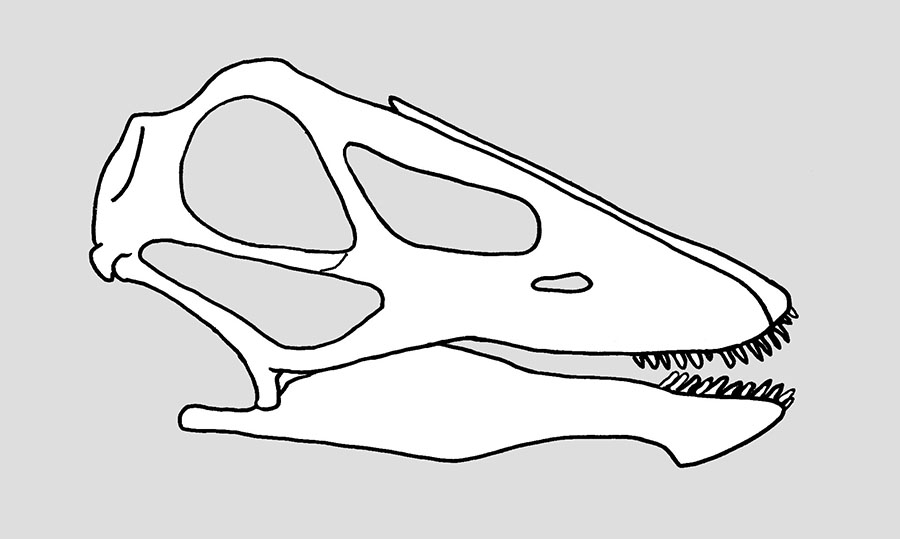Genus: Galeamopus TSCHOPP, MATEUS & BENSON, 2015
Etymology: Latin, galeam, "helmet," and Latin, opus, "need, necessity," which
literally translates to the German name Wilhelm (meaning "want helment, protection")
and its English translation William. Galeamopus remembers and honors the two
'Williams' intimately connected with the genoholotype specimen HMS 175" William
H. Utterback and Willliam J. Holland. Utterback found HMNS 175 in 1902 and
Holland described its braincase in 1906, and named the holotype species G.
hayi as Diplodocus hayi in 1924--although already stating that the morphological
differences between G. hayi and Diplodocus might be enouth to allow the erection
of a new genus in future. Galeamopus is also an allustion to the fact that
the fragil braincase is the described part of the holotype skeleton to date.
Species: hayi (HOLLAND, 1924) TSCHOPP, MATEUS & BENSON, 2015
(Type)
= Diplodocus hayi HOLLAND, 1924
Etymology: In honor of O. P. Hay.
Holotype: HMNS 175 (formerly CM 662)
Locality: Quarry A, Red Fork of the Powder River, Johnson County, Wyoming.
Horizon: Member? Morrison Formation.
Biostratigraphy: Apatosaurine interval 1.
Age: Comobluffian age, Tithonian Stage (originally listed ast Lower Kimmeridgian Stage), Uppermost Malm Epoch,
Late Jurassic.
Material:
Material: Only the "clavicle" and perhaps 2 dorsal arches remain
at the Carnegie Museum. The greater part of the skeleton, consisting of the
cranium, 10 cervicals, 5 dorsals, 33 caudals, numerous ribs and chevrons, scapulae,
coracoids, sternal plates, humeri, radii, left ulna and part of manus, pubes,
ischia, left tibia, fibulae, astragali, part pes, was transferred to the Cleveland
Museum of Natural History (CMNH 10670) and later to the Houston Museum of Natural
Science, where the skeleton has been mounted and is on exhibition.
Referred material:
Locality: Quarry B, Red Fork of the Powder River, Johnson County, Wyoming.
Horizon: Member? Morrison Formation.
Biostratigraphy: Zone?
Age: Age?, Stage?, Malm Epoch, Late Jurassic.
Material:
CM 36041: Spine of anterior caudal marked "662" on one side and "1256" on
the other.
Another similar marked dorsal arches haven't been re-catalogued.
Locality: Bone Cabin Quarry, 8 miles north of Como, Medicine Bow Anticline
(also called Flat top Anticline), Albany County, Wyoming.
Horizon: Salt Wash Member, Morrison Formation.
Biostratigraphy: Zone 2.
Age: Comobluffian age, Kimmeridgian Stage, Uppermost Malm Epoch, Late Jurassic.
Material:
AMNH 969: Nearly complete skull, atlas and axis.

= Diplodocus longus GALIANO & ALBERSDöRFER, 2010, AMNH 969
_____________________________________________________________________________________
Species: pabsti TSCHOPP & MATEUS, 2017
Etymology: In honor of Dr. Ben Pabst (born in Vienna, Austria, in January 26, 1949), who also created the skull reconstution and led the repreparation of the specimen and its mount at SMA. Pabst has led several paleontological excavations in Switzerland and the USA, and is highly skilled in fossil preparation and skeleton mounting.
Holotype: SMA 0011
Locality: Howe-Scott Quarry, on the western slops of the Bighorn mountains, Big horn County, Wyoming.
Horizon: Member? Morrison Formation.
Biostratigraphy:
Age: Comobluffian age, Upper Kimmeridgian Stage, Uppermost Malm Epoch,
Late Jurassic.
Material: Partial skull, 13 cervical vertebrae, 8 dorsal vertebrae, partial sacrum, cervical, dorsal, and sternal ribs, both scapulae and coracoids, both humeri, left ulna, radius, and manus (including one carpal eleemnt), right ilium and pubis, left ischium, left femur, tibia, fibula, astragalus, and pes.

Galeamopus pabsti (after TSCHOPP, MATEUS & BENSON, 2015) SMA 0011.
Referred material:
Locality: Felch Quarry 1 near Garden Park, Fremount County, Colorado.
Horizon: Member? Morrison Formation.
Biostratigraphy:
Age: Comobluffian age, Upper Kimmeridgian Stage, Uppermost Malm Epoch,
Late Jurassic.
Material:
USNM 2673 (formerly YPM 1922): Posterior portion of a skull.

